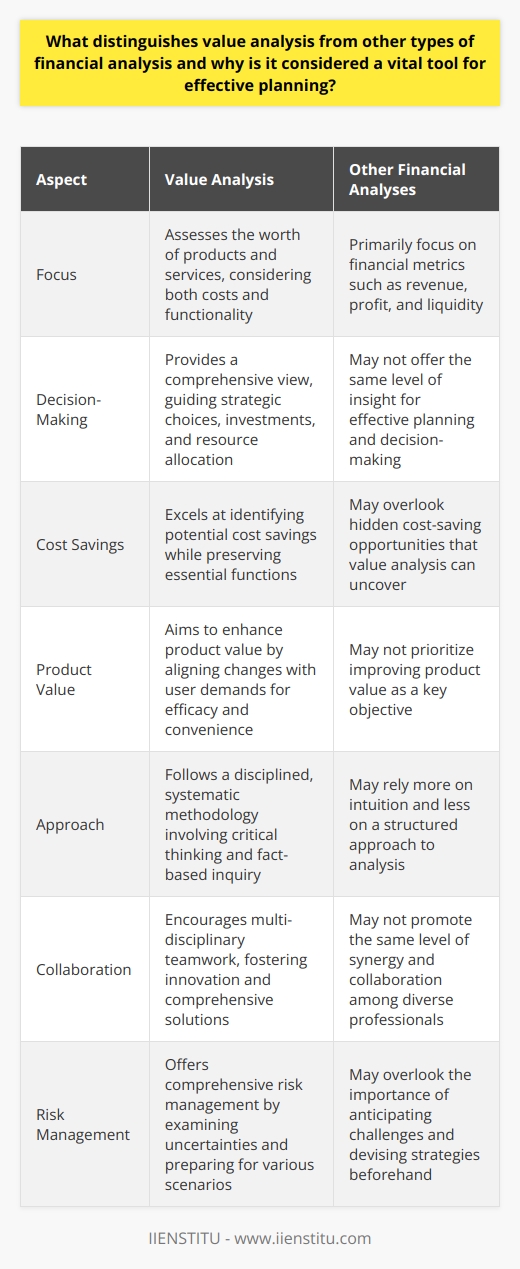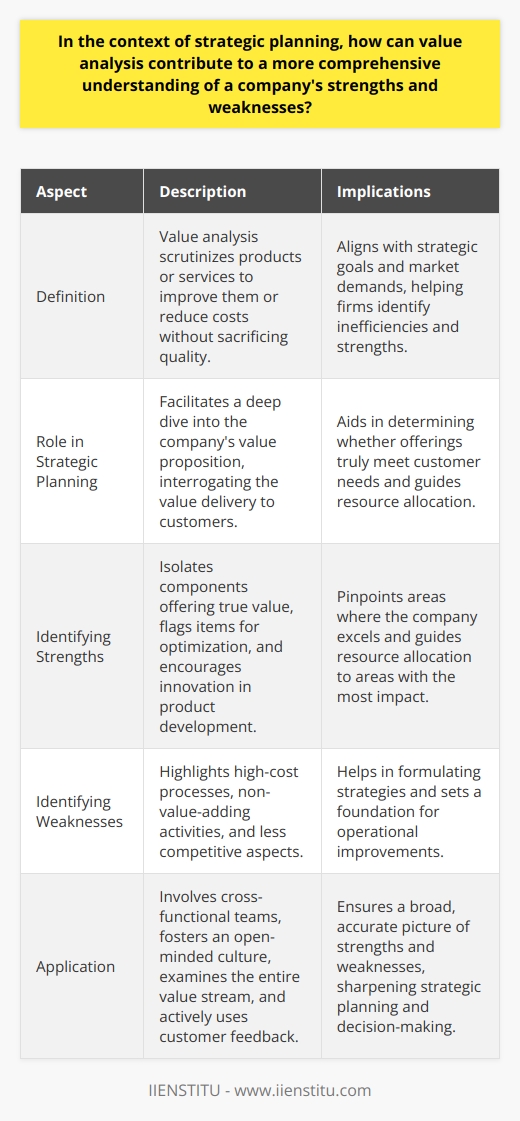
Value Analysis is a methodical approach used in product development and project management to improve the value of a product or project by analyzing its functions and costs. This technique is focused on maximizing the functionality of a product or service, while simultaneously reducing costs. It essentially balances the equation of function to cost, ensuring that customers get the best product at the least expense. In an increasingly competitive business landscape, Value Analysis has become a pivotal strategy for organizations aiming to streamline their operations, reduce unnecessary expenditures, and enhance product value.
Value Analysis is not to be confused with mere cost-cutting; instead, it is about finding the optimal solution that does not compromise the quality or performance of the product or service. By dissecting products and services into their constituent functions, businesses are able to identify and eliminate those which add little or no value to the end user.
Therefore, the significance of Value Analysis in business cannot be overstated—it allows for a methodical evaluation of a product's lifecycle, aids in effective planning, and provides a competitive edge in the market.
The Process of Value Analysis
Value Analysis is a procedural and strategic endeavor. It encompasses multiple phases that work cohesively to evaluate and enhance the value proposition of a product or service. Let's delve into the core components of this meticulous process.
Understanding the Concept of Function
Functionality lies at the heart of Value Analysis. It is essential to first understand the role and purpose of a product to effectively carry out a value analysis. The function of a product describes what the product is supposed to do and addresses the needs it fulfills for the customer. A product’s function can be categorized broadly into two types: basic and secondary functions. The basic function is the primary purpose of a product—the reason it exists—while secondary functions are supplementary features that enhance the product but may not be essential to its primary purpose.
Differentiating between these functions is crucial. While basic functions are generally untouchable in terms of cost reductions, secondary functions often present opportunities for trimming expenses. By identifying and focusing on the essential functions of a product, companies can simplify products and reduce costs without detrimentally impacting the product's core utility.
Cost Identification and Analysis
The second integral stage in Value Analysis is understanding the cost structure of a product—identifying what contributes to the total cost and how each part affects the overall value. Cost identification is an exhaustive task that requires detailed examination of materials, labor, overheads, and any other costs that contribute to the final expense of the product.
The relationship between cost and value is direct and intricate; a product must be reasonably priced while maintaining high quality to ensure value. Through Value Analysis, the goal is to lower costs by removing non-essential features that do not contribute significantly to the product’s value. This does not mean compromising on quality but rather aligning the cost structure with the functions that customers truly value.
Function Analysis and Cost Reduction
At the core of Value Analysis is an intricate dance between functionality and cost. The role of function analysis in cost reduction is not only about identifying what a product does but also quantifying and qualifying how much each function should cost. Each function is scrutinized to determine if it can be achieved in a more cost-effective manner, without sacrificing quality or customer satisfaction.
Case studies across various industries show how effective cost reduction through value analysis can streamline processes, reduce waste, and increase profitability. A classic example is in the automotive industry, where a relentless pursuit of Value Analysis has led to innovative materials usage, design simplifications, and alternative assembly techniques, thereby reducing manufacturing costs and increasing the value proposition to the end user.
Implementation of Value Analysis
To garner the full benefits of Value Analysis, a systematic, phased approach to implementation is required. This approach encompasses a series of structured steps that must be meticulously planned and adhered to.
Steps in Value Analysis Implementation
The implementation process is divided into five distinct phases: the information phase, the function analysis phase, the creative phase, the evaluation phase, and, finally, the implementation phase. During the information phase, all necessary data about the current product and processes is collected. In the function analysis phase, the team identifies and classifies the functions of the product or process.
The creative phase is a brainstorming session where ideas for improving value are generated without judgment or criticism. The evaluation phase involves critically analyzing these ideas, assessing their feasibility, and selecting the most viable options. Lastly, in the implementation phase, the chosen ideas are executed, and the product or service is monitored for improvements in value.
Challenges in Value Analysis Implementation
Despite its many benefits, implementing Value Analysis is not without challenges. Common hurdles include resistance to change from stakeholders who may be accustomed to traditional approaches, and lack of understanding of the value analysis methodology among team members, which can lead to skepticism and reluctance.
Furthermore, there are often cost implications associated with the implementation of new systems or designs that may dissuade decision-makers from fully committing to the process. Typically, this necessitates a careful assessment of long-term versus short-term costs and benefits.
How To Overcome Implementation Challenges
To effectively overcome these challenges, continuous training and education on value analysis must be implemented to ensure all stakeholders understand its benefits and methodologies. Additionally, securing top management commitment is crucial to provide the necessary support and resources for the value analysis process.
Creating a culture of value analysis within an organization can also foster an environment where employees proactively seek ways to add value and reduce costs, thereby ensuring the long-term success and sustainability of value analysis initiatives.
The Future of Value Analysis
Value Analysis is an evolving field, and as industries continue to evolve, so too must the techniques and applications of Value Analysis.
Emerging Trends in Value Analysis
The dynamic nature of technology and its rapid integration into various business processes is leading to significant changes in how Value Analysis is conducted. The incorporation of advanced software, data analytics, and automation tools is enabling deeper insights into functions and costs, thereby refining the process.
Additionally, the evolving role of value analysts is also an emerging trend—where they are now expected to have a broader skill set that includes proficiency in technology, a deeper understanding of market trends, and a strategic mindset.
Predicting the Future of Value Analysis
The impact of global trends on Value Analysis can be profound. Factors such as sustainability concerns, regulatory changes, and customer preferences will undoubtedly shape the parameters within which Value Analysis operates. These trends will necessitate that Value Analysis retain its flexibility and adaptability to remain relevant.
Furthermore, the future role of Value Analysis in strategic planning is set to be more pronounced. With increasing market pressures and the need for constant innovation, Value Analysis will be crucial in helping businesses identify opportunities for enhancing value while mitigating unnecessary costs.
The importance and role of Value Analysis in modern business cannot be overstated. It serves as a bridge between operational efficiency and customer satisfaction—balancing cost reduction with the delivery of highly valuable products and services. A comprehensive understanding and execution of Value Analysis can be a major determinant in a company's success, providing a clear direction in product development and business strategy.
Therefore, it is imperative for businesses to recognize the considerable benefits that a well-implemented Value Analysis process can offer. Whether it is through online certificate courses in the discipline or engaging in a problem solving skills course, enhancing one's understanding and capability in this field is a strategically sound investment. As organizations continue to navigate an ever-shifting business environment, Value Analysis stands as a testament to the necessity of continual improvement and adaptation in the pursuit of excellence.
Frequently Asked Questions
What distinguishes value analysis from other types of financial analysis and why is it considered a vital tool for effective planning?
Value Analysis in Financial Planning
In the realm of financial assessment, value analysis stands unique. It delves into the worth of products and services. Experts aim to maximize this worth. They assess every aspect. Costs do not escape scrutiny. Neither does the product function.
Core Differences
Value analysis distinguishes itself in several ways. It transcends mere cost examination. It includes functionality as a core metric. Other analyses may miss this aspect. They focus on financial metrics. These include revenue, profit, and liquidity. Value analysis integrates these with non-monetary aspects.
Effective Planning and Decision-Making
For effective planning, value analysis is crucial. It guides decisions with a comprehensive view. Planners see beyond mere numbers. They understand cost-to-benefit ratios better. This insight is powerful. It shapes strategic choices. Investments are aligned with it. Resource allocation also follows suit.
Identifying Cost Savings
Practitioners of value analysis excel at cutting costs. They seek the optimal expenditure. All while preserving function. No aspect of production is sacrosanct. All undergo scrutiny. The outcome often shows potential savings. These savings may remain hidden in other analyses.
Improving Product Value
Another key objective is enhancing product value. This does not always mean adding features. Sometimes, simplification is the answer. Users want efficacy, convenience. Thus, changes should align with these demands. Value analysis can pinpoint the exact needs.
A Disciplined Approach
This approach is disciplined. It follows a set methodology. Various stages mark the process. Firstly, information gathering. Secondly, alternative generation. Thirdly, evaluation. Finally, implementation is crucial. Each step involves critical thinking. Intuition plays a minor role. Facts and systematic inquiry guide the process.
Multi-disciplinary Teamwork
Value analysis relies on collaboration. Diverse professionals come together. Their expertise varies. Engineers, accountants, and marketers contribute. Such diversity breeds innovation. It drives more comprehensive solutions. Traditional financial analyses might not promote this synergy.
Comprehensive Risk Management
Risks come into the spotlight. Value analysis examines uncertainties. It prepares for various scenarios. These scenarios may affect value. Therefore, planning becomes more robust. It anticipates challenges. Moreover, it devises strategies beforehand. Other financial analyses may overlook such comprehensive risk preparations.
- Identifies potential cost reductions.
- Preserves essential functions.
- Enhances product value.
- Follows a systematic approach.
- Encourages multi-disciplinary teamwork.
- Offers comprehensive risk management.
In conclusion, value analysis is an invaluable tool. It provides clarity and depth. Other financial analyses may offer precision. Yet, they often miss the bigger picture. Value analysis captures both. It enables planners to navigate complex decisions. It fosters smart, sustainable growth. All these elements combined render it indispensable for effective planning.

In the context of strategic planning, how can value analysis contribute to a more comprehensive understanding of a company's strengths and weaknesses?
Understanding Value Analysis in Strategic Planning
Strategic planning marks a company's course toward growth and success. It entails a thorough evaluation of internal and external factors. Value analysis plays a critical role in this process. It forms a lens through which companies examine their operations.
Delving into Value Analysis
At its core, value analysis scrutinizes products or services. It aims to either improve them or reduce costs without sacrificing quality. This scrutiny aligns with strategic goals and market demands. Firms apply value analysis to spotlight inefficiencies and spotlight strengths.
Value analysis aids in strategic planning. It does so by facilitating a deep dive into the company's value proposition. This analysis is not superficial. Instead, it is a rigorous interrogation of the value delivery. Essentially, it makes stakeholders ask, "Do our offerings truly meet customer needs?"
Identifying Strengths and Weaknesses
Value analysis underpins strength identification. Here's how:
- It isolates components offering true value.
- It flags items that can undergo optimization.
- It encourages innovation in product development.
These insights pinpoint where a company excels. They also guide resource allocation to areas with the most impact.
Weaknesses emerge through value analysis. They become apparent in several ways:
- High-cost processes stand out.
- Non-value-adding activities become visible.
- Less competitive aspects reveal themselves.
Understanding these weaknesses helps in formulating strategies. It also sets a foundation for operational improvements.
Applying Value Analysis
How should companies apply value analysis? They must:
- Involve cross-functional teams.
- Foster an open-minded culture.
- Look at the entire value stream.
- Use customer feedback actively.
This approach ensures a broad, accurate picture of strengths and weaknesses.
In conclusion, value analysis is indispensable. Its contribution to a comprehensive understanding of company status is unmatched. It sharpens strategic planning and decision-making.
Strategic efforts without value analysis miss the mark. They overlook the nuances of operational effectiveness. With it, companies gain enhanced clarity. They visualize paths to optimization and excellence more clearly.

Is it possible to blend value analysis with other analysis methods in order to devise more robust planning strategies?
Blending Value with Various Analytical Approaches
The Case for Methodological Integration
Strategists often embrace value analysis. It highlights efficiency and cost-effectiveness. Yet, solitary reliance risks neglecting additional factors. Robust planning demands holistic views. Thus, integrating various methodologies is prudent.
Diverse Analysis for Enhanced Insight
Value analysis excels in optimizing value propositions. However, complexity in strategic environments abounds. Multiple methods enrich understanding. Consider SWOT, PESTEL, or Porter’s Five Forces. All offer distinct perspectives.
Synergy in Strategic Planning
Integrated approaches yield more nuanced strategies. They allow for cross-verification of findings. Insights emerge from a symphony of analyses. Strategy becomes resilient. It weaves multiple threads of understanding.
The Complementarity of Analyses
Value-with-Competitive Analysis – A potent mix arises. Value analysis secures efficiency. Competitive analysis couples it with market context. Strategists spot opportunities alongside potential cost reductions.
Value and Risk Analysis – Here, thoroughness matters. Value analysis identifies optimal resource use. Risk analysis safeguards against unpredictability. Plans gain in both prudence and ambition.
Value plus Scenario Planning – Strategists foresee multiple futures with scenario planning. Value analysis then identifies resource allocation. Every potential future contemplates efficiency.
Conclusion: Empowering Strategic Plans
Multiple methods infuse plans with depth. Every method fills a gap the others leave. Analysis becomes robust, adaptable, and comprehensive.
A multi-lens strategy entails constant learning. Perspectives shift, revealing newfound opportunities. Planners equipped with a diverse toolkit thrive. They craft strategies possessing both agility and substance.



